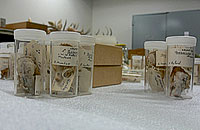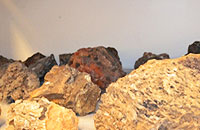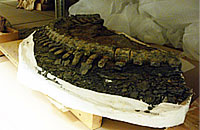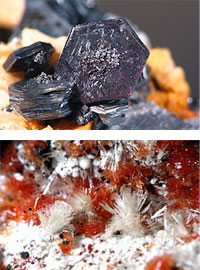
Bump/Macdonald Library
The Bump/Macdonald Library holds over 5000 books and reprints on a wide range of subjects, including geology, biology, paleontology, mineralogy and museum studies. The library does not provide circulation services, but on-site use of library materials can be arranged with prior approval.
Image: Stacks in the Bump/Macdonald Library, photo from Laurie Anderson

The
Museum holds a large collection of historical materials that date back to the
founding of South Dakota Mines, including correspondence, photographs, historical
artifacts, and related materials that tie the natural history of this region to
the human history. The map collection holds over 7500 maps in all media and
sizes, representing sites around the world.
Image: Geologic Maps in Museum Archives, photo from Laurie Anderson

The
Museum houses over 2000 biological specimens of plants and animals (shells,
skeletons, study skins, fluid-preserved specimens, herbarium folders and other
preparations). These specimens are used for research and teaching as well as
for comparative studies.
Image: Collections under curation in Biological Collections, photo from Laurie Anderson

Paleobotany Collections
The Museum's paleobotany collection contains several hundred fossil plant specimens primarily of Jurassic to late Pleistocene age. The most important specimens are ~120 million-year-old fossil cycads from the Dakota Sandstone near Edgemont, South Dakota, one of the largest collections from the former
Fossil Cycad National Monument. Other fossils include leaves, seeds, and petrified wood. Paleobotany also houses a modern herbarium with 200 plant folders, representing Black Hills and Badlands flora.
Image: Fossil cycads in Paleobotany Collections, photo from Laurie Anderson

The invertebrate paleontology collection includes specimens
from nearly every taxon of invertebrate animal. Major collections include
mollusks and arthropods of the Cretaceous Western Interior Seaway, insects of
the Western Interior Cenozoic, Cenozoic marine mollusks of the U.S. Gulf and
Atlantic Coastal Plains as well as the Paris Basin, worldwide marine and
freshwater Recent mollusks, and Gulf Coast Tertiary Foraminifera.
Image: Fossil mollusks housed in the Intervertebrate Collections, photo from Laurie Anderson

The
vertebrate paleontology collection consists of approximately 500,000 individual
specimens ranging in age from Ordovician through Pleistocene. Although the age
range of the collection spans a time frame of nearly 400 million years, most specimens
are derived from deposits of the Cretaceous Western Interior Seaway and the
Eocene-Oligocene of the White River Group in the northern Great Plains. Other
significant holdings include specimens from Miocene deposits of the northern
Great Plains, Pleistocene vertebrates from central Oregon, and Cretaceous
marine fossils from Antarctica. Collections include holdings of the Museum
proper as well as repository collections from the National Park Service, the U.S.
Forest Service, the Bureau of Land Management, the U.S. Army Corps of
Engineers, and several tribal agencies.
Image: Tail section of nearly complete Cretaceous mosasaur skeleton, photo from Laurie Anderson

The
mineralogical collections house over 75,000 specimens. Included in the
collections are the South Dakota collection containing the large diversity of
minerals found in the state (particularly in the Black Hills region) and a
worldwide systematic collection and hundreds of display quality specimens. Drill
cuttings and cores, mineral ore samples, well logs, and other data from
throughout South Dakota are also stored in this collection.
Image: (top) Sincosite-Ross Hannibal Mine, Lead, SD, photo from Tom Loomis
Image: (bottom) Type specimen Tiptopite - Tip Top Mine, Custer County, SD, photo from Tom Loomis